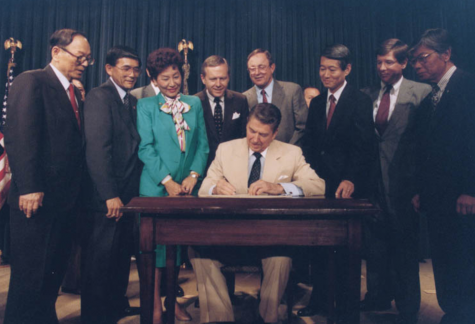NEIU’s Ronald Williams Library released a digital collection of the Japanese American Redress documents
May 16, 2018
NEIU’s Ronald Williams Library released a digital collection of the Japanese American Redress documents that focused on the the Commission on the Wartime Relocation and Internment of Civilians (CWRIC) hearings. The CWRIC hearings took place on NEIU’s main campus on September 22-23, 1981.

On February 19, 1942, President Roosevelt issued Executive Order 9066. This order forcibly detained 120,000 people of Japanese ancestry because they were considered a national security threat. Two-thirds of the people detained were American citizens and none of them were ever charged with espionage or sabotage.
The people whom were detained were held in the internment camps for an averaged three years. Many of these camps in poor conditions and sometimes hundreds of miles from their homes.
The project to digitalized the documents was first proposed by former NEIU archivist Dario Villa in 2014 in order to make them more accessible to the public.
In 2016, NEIU’s The Archives, Government Information and Periodicals librarian Hanna Ahn and El Centro Library Coordinator Geoff Brown began cataloguing the 823-paged transcript of the Chicago hearings into an online database to make the information more easily accessible for the public.
The collection contains the hearings, testimonies and individual accounts that were held in the internment camps; these hearings were held to investigate the ethical and constitutional objections of Executive Order 9066.
It would be several years before anybody would try to address this government-sanctioned racial injustice. This was attempted in the form of the Japanese redress hearings that took place in several cities, Chicago being one of them.
In Hiroshi Kadokura’s transcribed hearing, he recalled his 18-year-old self in the internment camp.
“The mess hall in which I was assigned to eat was frequently running out of butter and sugar and the portions of meat being served on my plate were getting skimpier and less frequent,” Kadokura said.
It turned out several white stewards were stealing the food and when confronted by the inmates, the military personnel defended the stewards.
Ahn said, “Imagine having your life uprooted because of how you look. You are told by the government to pack your entire life into a suitcase and move into a horse stall. You have no privacy. You are stripped of your civil rights and surrounded by armed soldiers.”
Asked why helping to create the database was important, Ahn said, “The internment of Japanese-Americans during World War II should be remembered so that this kind of tragedy does not happen again. It is also good to remember that the evacuation and internment happened because a racist idea was implemented in a very systematic way.
“One person, President Roosevelt, issued the order that authorized the internment—Executive Order 9066—but it was implemented by various government entities and supported by many people, elected officials and citizens alike.”
The digitized accounts of some, of the many, people affected by the Japanese internments camps are accessible to the public so that generations to come may not forget what happened in the past.
The database can be found at: http://collections.carli.illinois.edu/cdm/landingpage/collection/nei_japan







